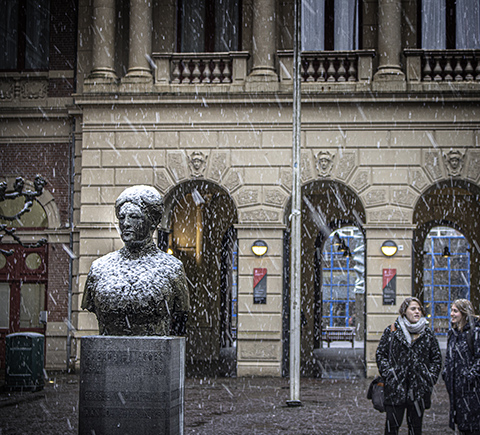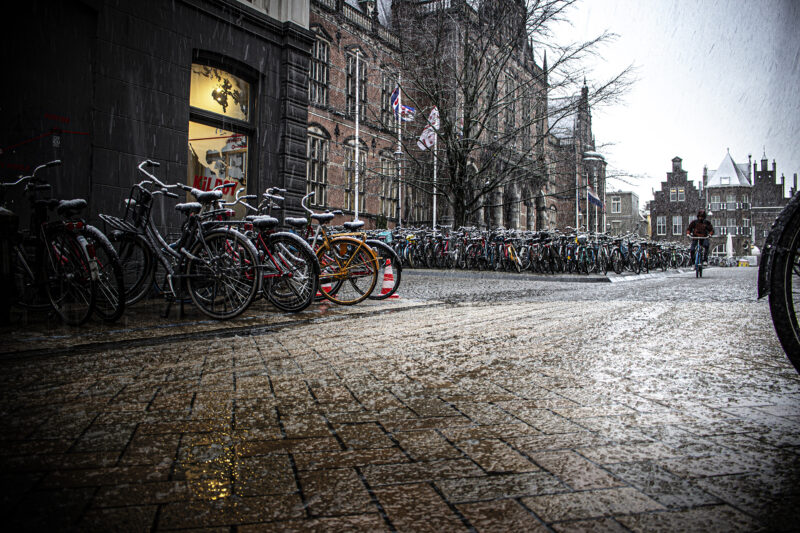
Ditch those city-centre buildings
What to do about the massive energy bill
50 million euros more a year in energy bills. That’s approximately 5 percent of the university’s total budget. Should people be worried about their jobs?
It’s certainly no fun. But, says Hans Biemans with the UG board of directors, the university can take it. Its reserves are substantial enough to absorb these high costs.
‘Even if the energy bills continue to be high for another year’, he says. ‘However, we should also take actions to prevent that from happening.’ After all, the reserves are meant to be invested in study programmes or research: the UG’s primary concerns. They’re not meant to patch budgetary holes.
It’s possible we’ll put an end to certain activities
The tricky part is that nobody knows exactly how long this will last and when the prices will stabilise. It’s also unclear to what extent the state will compensate universities. But Biemans does think energy will remain expensive and that it will have consequences. ‘We have to work towards balanced management. And we’ll look for actions to take in places that don’t affect the primary processes.’
That means some people will be affected. ‘It’s possible we’ll put an end to certain activities and that people will have to do something else.’, says Biemans. ‘That’s something you have to take into consideration. We can’t keep all the balls in the air.’
Establishing ‘comfort times’ should reduce energy consumption at the university by 20 percent. Will that be enough?
No, it will not. But Biemans says it’s a simple action with fast, major effects. In the meantime, the university is brainstorming other solutions. One thing the board wants to do is to modernise lighting at the UG at an accelerated rate.
It’s quite the operation, since everything would have to be changed to take LED lamps. Biemans estimates the project will cost ‘a few million’. The good news: ‘We’ll earn that back in three years.’
The university also wants to get more power from cogeneration. In the summer, cold water is pumped through the pipes to cool down warm buildings. After the water heats up, it gets stored and is used in winter to heat the buildings.
Many buildings at Zernike use this method, as does the UB. The faculty of medical sciences will soon also be heated by cogeneration and there are plans to hook the city centre buildings up to the grid. ‘We could create a loop system that we hook buildings such as the law faculty, the Harmonie building and the Academy buildings up to’, suggests Dick Jager, head of the Green Office.
Many buildings in the city centre are poorly insulated and have a G energy rating. When will the UG do something about this?
The short story? Not any time soon.
The government demands all office buildings have at least a C energy rating by January 1, 2023. But not a single city-centre building with a G rating – such as the University Museum, for example, or the law faculty’s office buildings – has been outfitted with double glazing or extra insulation.
The university can get away with this because all UG property is officially ‘educational’, which means they don’t have to meet the C rating criteria. On top of that, many of the buildings are listed, which means the rule doesn’t apply. However, the UG doesn’t want to lose all its money on heating. So what’s the deal?
Biemans explains that it’s not that simple. He wonders if the university should want to keep these buildings. Making them more sustainable would be a costly affair. And: ‘Our money won’t last forever.’
We simply don’t need these beautiful but inefficient buildings anymore
Many of these problem buildings are being used by the law and arts departments. But the law faculty will soon move to the old public library. ‘That’s currently being renovated to meet modern requirements’, says Biemans.
After that, the Harmony complex is scheduled to be renovated. ‘We also need extra room to make sure people have a quiet place to work during the renovations.’
But what happens after that? ‘If you ask me, we simply don’t need these buildings anymore. They may be beautiful, but they’re not energy efficient. I think it might be best if we let them go.’
Biemans realises that not everyone would like that. ‘Many people are charmed by the buildings in the city centre’, he says. ‘I get that, but some of them are simply uneconomical in terms of energy.’
He promises that there are some buildings the university would never sell, such as the Academy building. ‘These are the core of our university, we’d never get rid of them.’ But there are also buildings that are only needed for a limited time period. ‘These are buildings we could get rid of. That’s our basis for maintenance.’
What about Nijenborgh 4? It’s the UG’s biggest energy guzzler, but because the Faculty of Science and Engineering (FSE) doesn’t have enough room, it won’t be torn down any time soon.
Nijenborgh 4 is a property ‘no one wants in their portfolio’, Biemans admits. It has an outdated extractor system and metal window frames, making it a pain in the neck. But because FSE doesn’t have enough room, it can’t be torn down after the Feringa Building is finished, which was the original plan.
You could put solar panels all over the south façade of the Duisenberg building
Biemans can’t tell the future when it concerns Nijenborgh 4. It’s clear that FSE needs the space. But he hasn’t figured out yet how to give that to the faculty. One option is to tear down Nijenborgh 4 and build new property in its place. But stripping it down to its bare bones and rebuilding it might be more sustainable. Another option is tearing it down and finding a different location for a new building. ‘There are currently studies being done to figure out how to best do this.’
Until then, FSE will corral its people in as few buildings as possible to conserve energy.
Shouldn’t the UG install more solar panels?
More solar panels sounds like an obvious solution, but essentially all roofs that can have solar panels installed already have them, says Biemans. New builds always get outfitted with solar panels. Any roofs left, such as that of the Academy building, either aren’t strong enough, or won’t be able to provide enough power.
But, says Dick Jager, perhaps it’s worth reconsidering. Perhaps the previously uneconomic roofs will now be profitable. Perhaps the UG should think a bit more outside the box. ‘Take the Duisenberg building for example. You could put solar panels all over the southern façade. You could even make it look nice, with different colours.’
Is there anything employees can do to help?
Yes! Turn off the lights. Switch off your computer when you leave for the day. Don’t complain about the cold, but put on an extra sweater. That’s about it, though, says Jager.
But Biemans hopes the academic community can provide some extra input, he says. The university possesses a wealth of knowledge and inventiveness, says Biemans, and he wants to utilise that. ‘I’m optimistic about our abilities. An organisation like ours can only make it to four hundred years old by being resilient and understanding what’s needed to keep the university going.’
